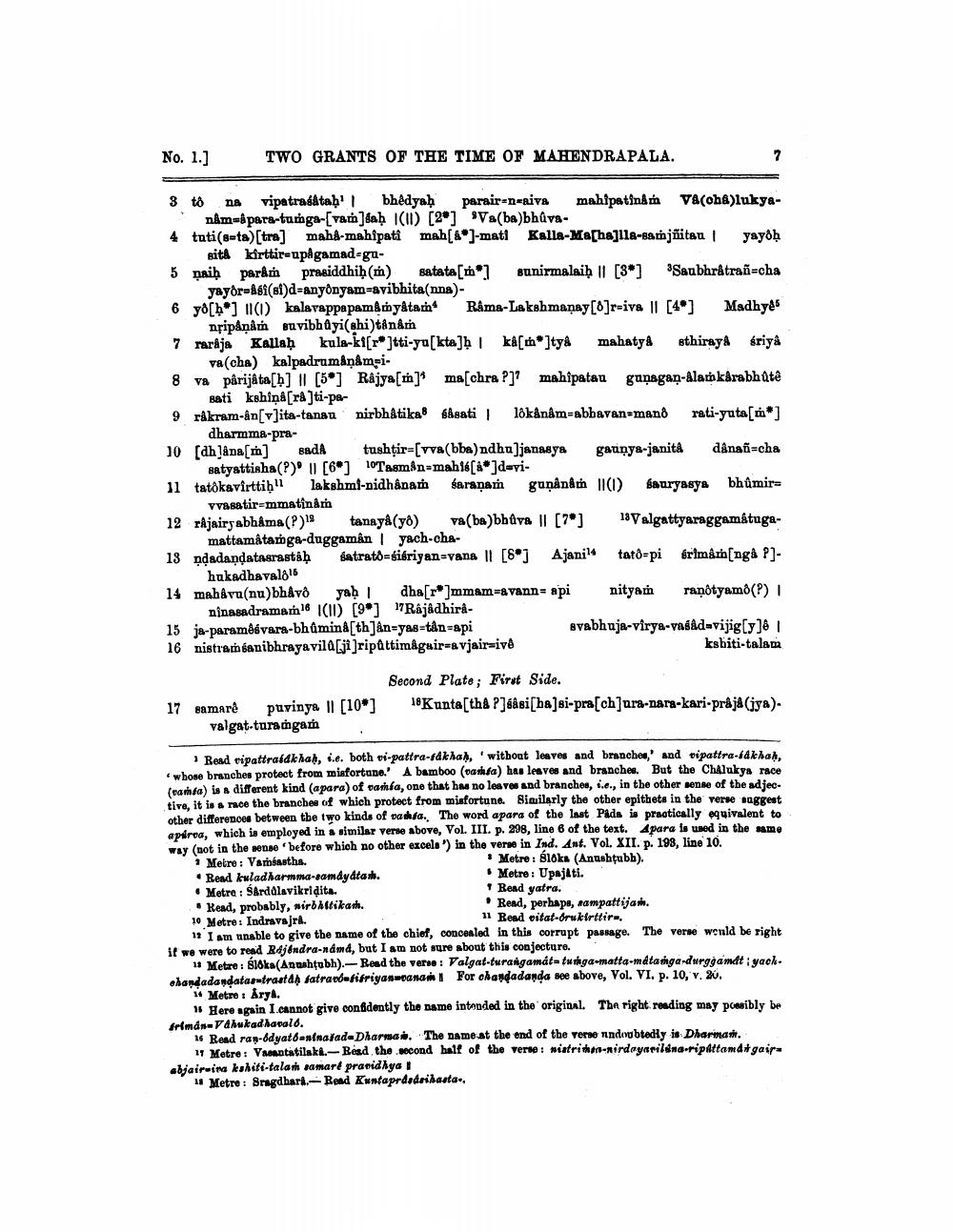________________
No. 1.]
TWO
TWO GRANTS OF THE TIME OF MAHENDRAPALA.
3 to na vipatrasatah' bhedyaḥ parair=n=riva mahipatin& VA(oha)lukya
nâm=¶-tunga-[vam]laḥ I(II) [2] "Va(ba)bhůva4 tuti(seta) (tra] maha-mahipati mah[&]-mati Kalla-Ma[ha]lla-samjñitau yayoḥ
sita kirttireupAgamad-ga5 naiḥ para prasiddhiḥ(m) satata[m*) sunirmalaiḥ || [3*] Saubhrátrañ-cha
yayor-Alli(el)d-anyonyam=avibhita(nna)6 yo[b] 1) kalavappapamâmy&tam* Râma-Lakshmanay[0]r-iva || [4] Madhyes
npipánům suvibhayi(shi)tênår 7 raraja Kallah kula-ki[r*]tti-ya[kta]} 1 ka[]tya mahatya sthiraya sriya
va(cha) kalpadrumaņām=i. 8 va pärijata[b] l1 [5] Rajya[m] machra ?]'mahipatau gunagan-alamkarabh atë
Bati kehiņå[ra]ti-pa9 råkram-&n[v]ita-tanau nirbhàtika sasati lokánam-abhavan mand rati-yuta [*]
dharmma-pra30 [ah låna[] sada tushţir=[vva(bbs)ndhu)janasya gatinya-janità dânañ-cha
satysttisha(?)' 0 [6] 10Tasman-mahiế[a ]davi11 tatökavirttiḥ" lakshmi-nidhanam Saranam guņânam ||(1) Sauryasya bhûmir
vvasatir-mmatinária 12 rájairyabhama(?)18 tanay&(78) va(ba)bhůva || [7] Valgattyaraggamåtuga
mattamâtanga-duggaman yach-cha13 ndadandatasrastaḥ satratô=sibriyan-vana || [6] Ajani tatð=pi srimâm[ngå P]
hukadhavald 14 mahavu(nu)bhávô yaḥ| dha[r*]mmam=avann- api nityam raņôtyamo(P) I
ninasadraman 18 (II) [98] Rajadhird15 ja-paramdsvara-bhumina[th]An-yas-tan-api
svabhuja-virya-vasád=vijig[y]8 16 nistramsanibhrayavila[ji]ripittimáguir=&vjair=ivê
ksbiti-talama
Second Plate; First Side.
18Kunta[tha ?]&&si[hs]si-pra[ch]ura-nara-kari-pråja (iya).
17 samaré puvinya || [10"]
valgat-taragam
Read ripattraidkhah, i.e. both vi-pattra-fdkha,' without leaves and branches and vipattra-fdkhal, whose branches protect from misfortune.' A bamboo (Dama) has leaves and branches. But the Chalukys race teamfa) is a different kind (apara) of varia, one that has no lesves and branches, 1.e., in the other sense of the adjective, it is a race the branches of which protect from misfortune. Similarly the other epithets in the verse taggest other differences between the two kinds of data. The word apara of the last Pids is practically equivalent to apirea, which is employed in a similar verse above, Vol. III. p. 208, line 6 of the text. 4para is used in the same way (not in the sense before which no other excela") in the verse in Ind. Ant. Vol. XII. p. 198, line 10. : Metre : Vamasths.
• Metre: sloks (Anushtubb). • Read kuladharmma-samdytas.
• Metre : Upajati. • Metre : Ś&rdülavikridita.
+ Read yatra. Read, probably, wirbaltikan.
Read, perhaps, sampattijan. 10 Metre: Indravajra.
11 Read citat-drukirttir, 11 I am unable to give the name of the chief, concealed in this corrupt passage. The verse would be right it we were to read Rajandra-ndmd, but I am not sure about this conjecture.
1 Metre: sloka (Anushțubh).- Read the verso: Valgat-turangamáttunga-matta-mdtanga-durgjandt yach. shandadandatar-tractan Satrandafifriyaswana For ohandadanda se above, Vol. VI. p. 10, v. .
14 Metre : Arya.
15 Here again I cannot give confidently the name intended in the original. The right reading may posibly be frimas Vahukadhavalo.
16 Read ran-6dyatdannatad-Dharma. The namest the end of the verse indoubtedly is Dharmant.
11 Metre: Vrantatilaki.-Bead the second half of the verso: wiatrisha-Nirdayarilena.riplttamdit gairabjair-it kahiti-talash samaré pranidhya!
11 Metre : Sragdhark - Read Kuntaprdednihasta..




